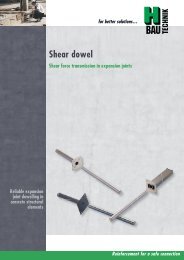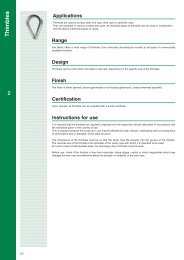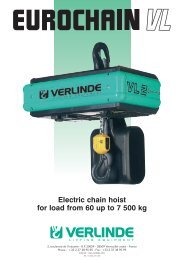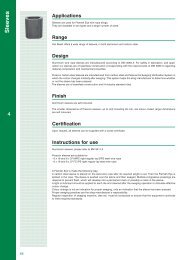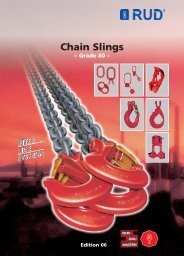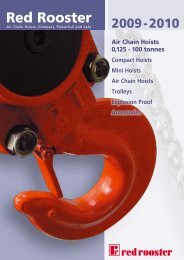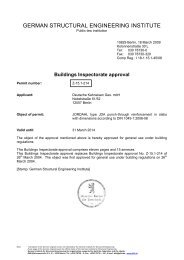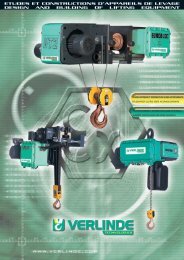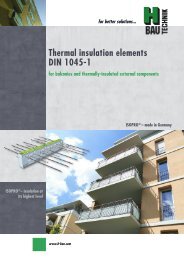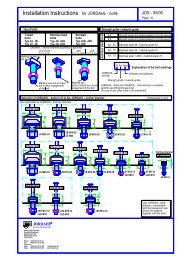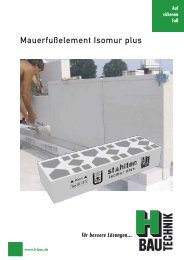Verlinde Electric Wire Rope Hoist
Verlinde Electric Wire Rope Hoist
Verlinde Electric Wire Rope Hoist
You also want an ePaper? Increase the reach of your titles
YUMPU automatically turns print PDFs into web optimized ePapers that Google loves.
VTEUROBLOC®VT<strong>Electric</strong> wire rope hoist for load from 800 to 100.000 kgOPTIONSIn addition to standard equipment each EUROBLOC VT can be fitted with mechanical or electrical optional features in order to satisfyyour specific requirements:• Non standard rail width.• Special rail gauge.• Higher travelling speed.• Radio or infra-red remote control.• Travelling limit switch.• Derailment catches on double girdertrolley.• Boogies trolley (only with HPN).• Missing phase control.• Monitor 2 (MT2).• 2 or 3 steps overload device.• Overload device temporization.• Optical and audible warning connectedto overload limit switch.• Non standard main voltage.• Rain cover.• Klaxon on pendant box.• Explosion proof and / or spark proofversion.• Load indication device.• Motors thermal protection.• Class H motors.• Heating device on motor.• Stainless steel hoist electrical cubicleIP 55 or IP 65.• CSA electrical control.• Hook operated upper limit switches.• Ramshorm hook.• Additional brake.• Lifting variable speed.• Crash protection with electronic cell.Standards and hoisting regulationsCE directive. Since 1st January 1995, the EuropeanMachinery Directive 98/37 EEC obliges that machineconstructors ensure that their machinery complieswith certain reglementations, standards, nationallegislations and technical specifications.Every VERLINDE product is CE labelled and is delivered with anCE compliance certificate (annex IIA) or with an incorporationcertificate (annex IIB).FEM: European lifting equipment association.SWP: A Safe Working Period is calculated for each electricalhoists unit according to the average operating time of thehoisting equipment, load capacity and class of application. Afterthis period, a general service carried out by the constructor isnecessary.Class of operation. According to FEM classification, twofundamental criteria must be taken into account : the type ofduty and the class of duty (according to average daily operationtime average load).ISO standard. Classes of operation can also be defined accordingto ISO grouping (1Am = M4, 2m = M5, 3m = M6, etc.).Type of duty. Light service. Equipment rarely subject tomaximum load and frequently to very little load. Medium service.Equipment quite often subject to maximum load and frequentlyto very little load. Heavy service. Equipment frequently subjectto maximum load and frequently to medium load. Very heavyservice. Equipment frequently subject to maximum or nearmaximum load.Average dailyoperating time (hours)Class of duty1 L1 LightV0,250,51 2 4 8 16T2 V0,5 T3 V1 T4 V2 T5 V3 T6 V4 T71Bm M3 1Am M4 2 m M5 V4 M6Typeof service2 L2 Medium3 L3 Heavy1B m M3 1Am M4 2 m M5 3 m1Bm M3 1A m M4 2 m M5 3 m M6M64 L4 Very heavy1Am M4 2 m M5 3 m M6Group1Bm M3 1A m M4 2 m M5 3 m M6Duty factor*25 %30 %40 %50 %Number of star starts per hour150180240300■ FEM 9511 standards classification. ■ ISO standards classification.<strong>Hoist</strong>ing time + lowering time* Duty factor in % =<strong>Hoist</strong>ing time + idle time + lowering time + idle timex 100



